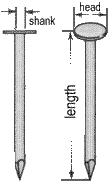

Box nails -- intended for lighter
construction -- are the same length per penny size as common
nails, but their shanks
and heads are slightly narrower.![]()
|
Size number in "d" = pennies |
Number per pound |
|||
| 2 d | 1 | 0.070 ( 15 ) |
11/64 | 840 |
| 3 d | 1 1/4 | 0.085 ( 14 ) |
13/64 | 530 |
| 4 d | 1 1/2 | 0.1 ( 12 1/2 ) |
1/4 | 300 |
| 5 d | 1 3/4 | 0.1 ( 12 1/2 ) |
17/64 | 260 |
| 6 d | 2 | 0.115 ( 11 1/2 ) |
17/64 | 170 |
| 7 d | 2 1/4 | 0.115 ( 11 1/2 ) |
17/64 | 150 |
| 8 d | 2 1/2 | 0.131 ( 10 1/4 ) |
9/32 | 105 |
| 9 d | 2 3/4 | 0.131 ( 10 1/4 ) |
9/32 | 95 |
| 10 d | 3 | 0.148 ( 9 ) |
5/16 | 65 |
| 12 d | 3 1/4 | 0.148 ( 9 ) |
5/16 | 60 |
| 16 d | 3 1/2 | 0.162 ( 8 ) |
11/32 | 44 |
| 20 d | 4 | 0.195 ( 6 ) |
13/32 | 30 |
| 30 d | 4 1/2 | 0.210 ( 5 ) |
7/16 | 22 |
| 40 d | 5 | 0.230 ( 4 ) |
15/32 | 18 |
| 50 d | 5 3/8 | 0.250 ( 3 ) |
1/2 | 14 |
| 60 d | 6 | 0.260 ( 2 ) |
17/32 | 10 |
Finishing nails have much smaller heads that can be concealed after the nails have been driven. These nails are used for applying trim and other areas where appearance is important. Click here to see a diagram of sizes of finishing nails, listing for each size its length, the diameter of its shank and its head, and the number of nails per pound.
Roofing nails have a large head that are intended to hold shingles and are usually galvanized.
Drywall nails look the same as roofing nails but are not galvanized.
Return to the article on nails.
Also see construction.
https://inform.quest/_art
Copyright © 1996-![]()